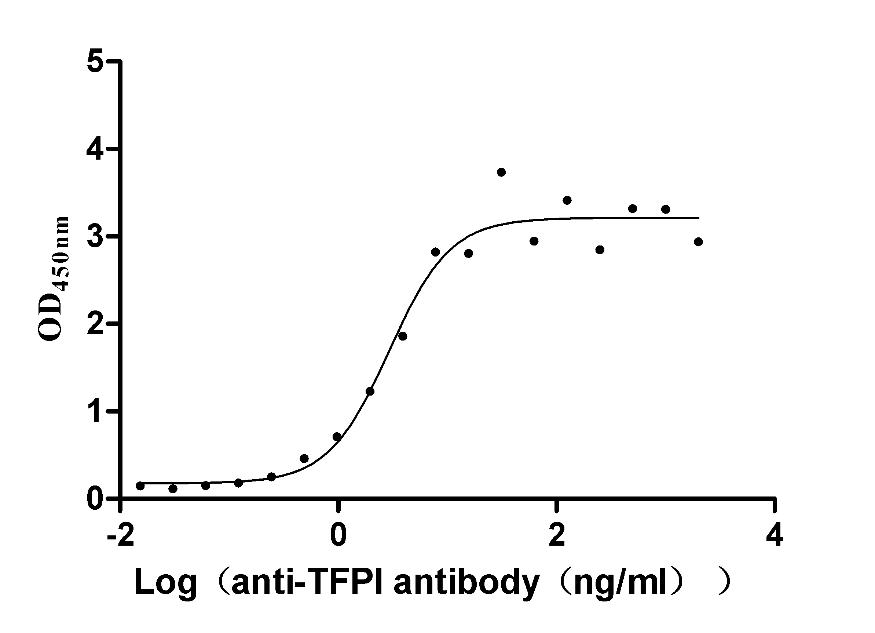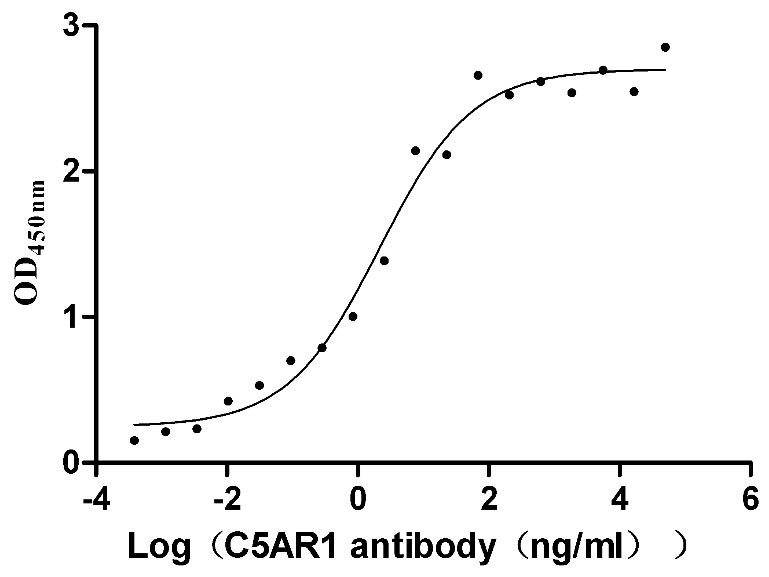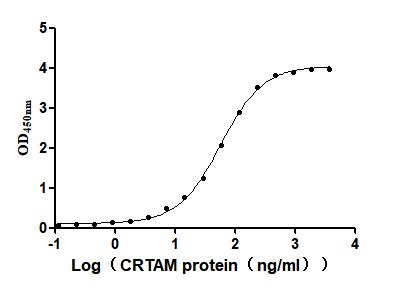Recombinant Mouse Zinc finger protein 36, C3H1 type-like 1 (Zfp36l1)
-
中文名稱:小鼠Zfp36l1重組蛋白
-
貨號(hào):CSB-YP026449MO
-
規(guī)格:
-
來(lái)源:Yeast
-
其他:
-
中文名稱:小鼠Zfp36l1重組蛋白
-
貨號(hào):CSB-EP026449MO
-
規(guī)格:
-
來(lái)源:E.coli
-
其他:
-
中文名稱:小鼠Zfp36l1重組蛋白
-
貨號(hào):CSB-EP026449MO-B
-
規(guī)格:
-
來(lái)源:E.coli
-
共軛:Avi-tag Biotinylated
E. coli biotin ligase (BirA) is highly specific in covalently attaching biotin to the 15 amino acid AviTag peptide. This recombinant protein was biotinylated in vivo by AviTag-BirA technology, which method is BriA catalyzes amide linkage between the biotin and the specific lysine of the AviTag.
-
其他:
-
中文名稱:小鼠Zfp36l1重組蛋白
-
貨號(hào):CSB-BP026449MO
-
規(guī)格:
-
來(lái)源:Baculovirus
-
其他:
-
中文名稱:小鼠Zfp36l1重組蛋白
-
貨號(hào):CSB-MP026449MO
-
規(guī)格:
-
來(lái)源:Mammalian cell
-
其他:
產(chǎn)品詳情
-
純度:>85% (SDS-PAGE)
-
基因名:
-
Uniprot No.:
-
別名:Zfp36l1; Brf1; Tis11b; mRNA decay activator protein ZFP36L1; Butyrate response factor 1; TPA-induced sequence 11b; Zinc finger protein 36; C3H1 type-like 1; ZFP36-like 1
-
種屬:Mus musculus (Mouse)
-
蛋白長(zhǎng)度:Full length protein
-
表達(dá)區(qū)域:1-338
-
氨基酸序列MTTTLVSATI FDLSEVLCKG NKMLNYSTPS AGGCLLDRKA VGTPAGGGFP RRHSVTLPSS KFHQNQLLSS LKGEPAPSLS SRDSRFRDRS FSEGGERLLP TQKQPGSGQV NSSRYKTELC RPFEENGACK YGDKCQFAHG IHELRSLTRH PKYKTELCRT FHTIGFCPYG PRCHFIHNAE ERRALAGGRD LSADRPRLQH SFSFAGFPSA AATAAATGLL DSPTSITPPP ILSADDLLGS PTLPDGTNNP FAFSSQELAS LFAPSMGLPG GGSPTTFLFR PMSESPHMFD SPPSPQDSLS DHEGYLSSSS SSHSGSDSPT LDNSRRLPIF SRLSISDD
-
蛋白標(biāo)簽:Tag?type?will?be?determined?during?the?manufacturing?process.
The tag type will be determined during production process. If you have specified tag type, please tell us and we will develop the specified tag preferentially. -
產(chǎn)品提供形式:Lyophilized powder
Note: We will preferentially ship the format that we have in stock, however, if you have any special requirement for the format, please remark your requirement when placing the order, we will prepare according to your demand. -
復(fù)溶:We recommend that this vial be briefly centrifuged prior to opening to bring the contents to the bottom. Please reconstitute protein in deionized sterile water to a concentration of 0.1-1.0 mg/mL.We recommend to add 5-50% of glycerol (final concentration) and aliquot for long-term storage at -20℃/-80℃. Our default final concentration of glycerol is 50%. Customers could use it as reference.
-
儲(chǔ)存條件:Store at -20°C/-80°C upon receipt, aliquoting is necessary for mutiple use. Avoid repeated freeze-thaw cycles.
-
保質(zhì)期:The shelf life is related to many factors, storage state, buffer ingredients, storage temperature and the stability of the protein itself.
Generally, the shelf life of liquid form is 6 months at -20°C/-80°C. The shelf life of lyophilized form is 12 months at -20°C/-80°C. -
貨期:Delivery time may differ from different purchasing way or location, please kindly consult your local distributors for specific delivery time.Note: All of our proteins are default shipped with normal blue ice packs, if you request to ship with dry ice, please communicate with us in advance and extra fees will be charged.
-
注意事項(xiàng):Repeated freezing and thawing is not recommended. Store working aliquots at 4°C for up to one week.
-
Datasheet :Please contact us to get it.
靶點(diǎn)詳情
-
功能:Zinc-finger RNA-binding protein that destabilizes several cytoplasmic AU-rich element (ARE)-containing mRNA transcripts by promoting their poly(A) tail removal or deadenylation, and hence provide a mechanism for attenuating protein synthesis. Acts as a 3'-untranslated region (UTR) ARE mRNA-binding adapter protein to communicate signaling events to the mRNA decay machinery. Functions by recruiting the CCR4-NOT deadenylating complex and components of the cytoplasmic RNA decay machinery to the bound ARE-containing mRNAs, and hence promotes ARE-mediated mRNA deadenylation and decay processes. Induces also the degradation of ARE-containing mRNAs even in absence of poly(A) tail. Binds to 3'-UTR ARE of numerous mRNAs. Positively regulates early adipogenesis by promoting ARE-mediated mRNA decay of immediate early genes (IEGs). Promotes ARE-mediated mRNA decay of mineralocorticoid receptor NR3C2 mRNA in response to hypertonic stress. Negatively regulates hematopoietic/erythroid cell differentiation by promoting ARE-mediated mRNA decay of the transcription factor STAT5B mRNA. Positively regulates monocyte/macrophage cell differentiation by promoting ARE-mediated mRNA decay of the cyclin-dependent kinase CDK6 mRNA. Promotes degradation of ARE-containing pluripotency-associated mRNAs in embryonic stem cells (ESCs), such as NANOG, through a fibroblast growth factor (FGF)-induced MAPK-dependent signaling pathway, and hence attenuates ESC self-renewal and positively regulates mesendoderm differentiation. May play a role in mediating pro-apoptotic effects in malignant B-cells by promoting ARE-mediated mRNA decay of BCL2 mRNA. In association with ZFP36L2 maintains quiescence on developing B lymphocytes by promoting ARE-mediated decay of several mRNAs encoding cell cycle regulators that help B cells progress through the cell cycle, and hence ensuring accurate variable-diversity-joining (VDJ) recombination and functional immune cell formation. Together with ZFP36L2 is also necessary for thymocyte development and prevention of T-cell acute lymphoblastic leukemia (T-ALL) transformation by promoting ARE-mediated mRNA decay of the oncogenic transcription factor NOTCH1 mRNA. Involved in the delivery of target ARE-mRNAs to processing bodies (PBs). In addition to its cytosolic mRNA-decay function, plays a role in the regulation of nuclear mRNA 3'-end processing; modulates mRNA 3'-end maturation efficiency of the DLL4 mRNA through binding with an ARE embedded in a weak noncanonical polyadenylation (poly(A)) signal in endothelial cells. Also involved in the regulation of stress granule (SG) and P-body (PB) formation and fusion. Plays a role in vasculogenesis and endocardial development. Involved in the regulation of keratinocyte proliferation, differentiation and apoptosis. Plays a role in myoblast cell differentiation.
-
基因功能參考文獻(xiàn):
- the ZFP36L1-dependent regulation of bile acid metabolism is an important metabolic contributor to obesity and hepatosteatosis. PMID: 28891815
- The Zfp36l1 therefore act as posttranscriptional safeguards against chromosomal instability and replication stress by integrating pre-TCR and IL-7 signaling with DNA damage and cell cycle control. PMID: 27566829
- Our data indicated that ZFP36L1 could act as an enhancer of osteoblastic differentiation but a repressor of adipogenic differentiation, supporting the notion that decreased ZFP36L1 expression in bone marrow stem cells might contribute to aging-related bone loss. PMID: 28206953
- ZFP36L1 is the regulator of a post-transcriptional hub that determined the identity of marginal-zone B cells by promoting their proper localization and survival. ZFP36L1 controlled a gene-expression program related to signaling, cell adhesion and locomotion; it achieved this in part by limiting expression of the transcription factors KLF2 and IRF8, which are known to enforce e follicular B cell phenotype. PMID: 28394372
- ZFP36L1 and ZFP36L2 suppress an evolutionarily conserved posttranscriptional regulon consisting of messenger RNAs whose protein products cooperatively promote transition into the S phase of the cell cycle. PMID: 27102483
- Myeloid ZFP36 may fully compensate for loss of ZFP36L1. PMID: 25299049
- Challenging the renal osmotic gradient by submitting mice to water deprivation, diuretic administration, or high-Na(+) diet increased renal Tis11b and decreased mineralocorticoid receptor expression, particularly in the cortex. PMID: 24700863
- Data revealed that ZFP36L1 and ZFP36L2 bound to the 3' untranslated region (UTR) of MAPK phosphatase-1 (MKP-1) mRNA and downregulated Mkp-1 3'UTR-mediated luciferase activity. PMID: 22701344
- I postulate that the embryonic arrest linked to the DeltaN-Zfp36l2 truncation might be related to its resistance to stimulus-induced down-regulation. PMID: 22367205
- ZFP36L1 has a critical role in lymphocyte development and may function as a tumor suppressor. PMID: 20622884
- Results suggest that lack of Zfp36L1 expression during mid-gestation results in the abnormal stabilization of one or more mRNAs whose encoded proteins lead directly or indirectly to abnormal placentation and fetal death. PMID: 15226444
- Data suggest an important role for butyrate response factor-1 in osteoblasts within the molecular network of parathyroid hormone-dependent bone remodeling. PMID: 15465005
- Knocking down TIS11b expression in primary adrenocortical cells with small interfering (si)RNAs clearly indicated that TIS11b participates in the control of both basal and, to a larger extent, ACTH-induced VEGF mRNA expression levels PMID: 15467755
- These data implicate Zfp36l1as a negative regulator of Vegf-a gene activity during development. PMID: 17013884
- Since specific inhibitors of p38 MAP kinase completely blocked Tis11B induction, we conclude that expression of the Tis11B gene is regulated at least in part by this signaling pathway which plays a central role in myogenesis. PMID: 17889962
- Results suggest that TIS11b suppression of 3.5-kb mRNA is coupled to enhanced steroidogenic acute regulatory protein translation leading to increased cholesterol metabolism. PMID: 19179481
顯示更多
收起更多
-
亞細(xì)胞定位:Nucleus. Cytoplasm. Cytoplasmic granule. Cytoplasm, P-body.
-
組織特異性:Expressed in preadipocytes and adipocytes. Expressed in the proximal and distal tubules in the renal cortex (at protein level). Expressed in ovary, heart, kidney, lung, spleen and thymus. Weakly expressed in brain, liver and testis. Expressed in osteoblas
-
數(shù)據(jù)庫(kù)鏈接:
Most popular with customers
-
Recombinant Rabbit Tissue factor pathway inhibitor (TFPI) (Active)
Express system: Mammalian cell
Species: Oryctolagus cuniculus (Rabbit)
-
Recombinant Human C5a anaphylatoxin chemotactic receptor 1 (C5AR1)-VLPs (Active)
Express system: Mammalian cell
Species: Homo sapiens (Human)
-
Recombinant Mouse Cytotoxic and regulatory T-cell molecule (Crtam), partial (Active)
Express system: Mammalian cell
Species: Mus musculus (Mouse)
-
Recombinant Human C-C chemokine receptor type 5 (CCR5)-VLPs (Active)
Express system: Mammalian cell
Species: Homo sapiens (Human)















